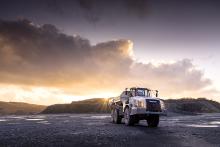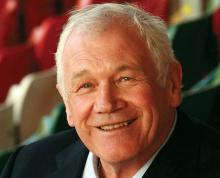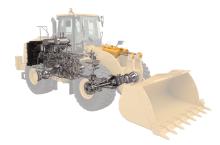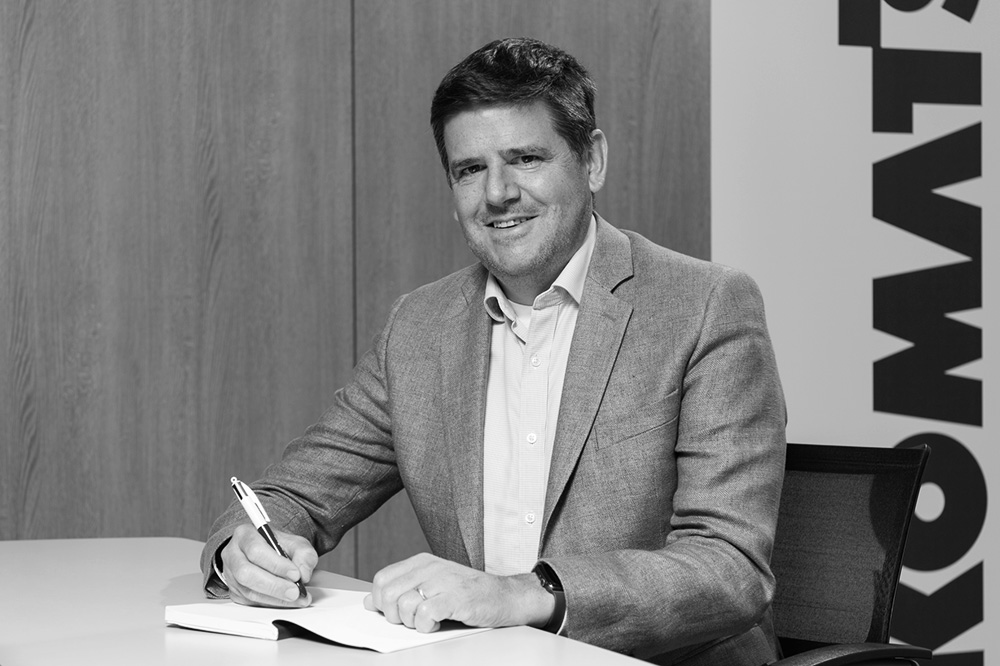
Komatsu has more than doubled its African product sales in the last two-and-a-half years, with year-on-year double-digit growth forecast for the next three years. The world’s second-biggest off-highway equipment manufacturer’s 2022-published mid-term management plan includes becoming one of Africa’s biggest-selling original equipment manufacturers (OEM) by 2025, with ongoing continent-based employee recruitment- and distribution-partnership widening and strengthening seen as critical to achieving that goal.
In May 2021, Eric Perben, a French national, became general manager of Komatsu’s new African business, a business covering 40 countries from Angola to the Democratic Republic of the Congo (DRC) north, excluding Egypt and North Sudan, which come under Komatsu’s Middle East business. Komatsu has a separate major southern Africa business covering nine countries: South Africa, Mozambique, Botswana, Namibia, Zambia, Zimbabwe, Malawi, Madagascar, and Mauritius.
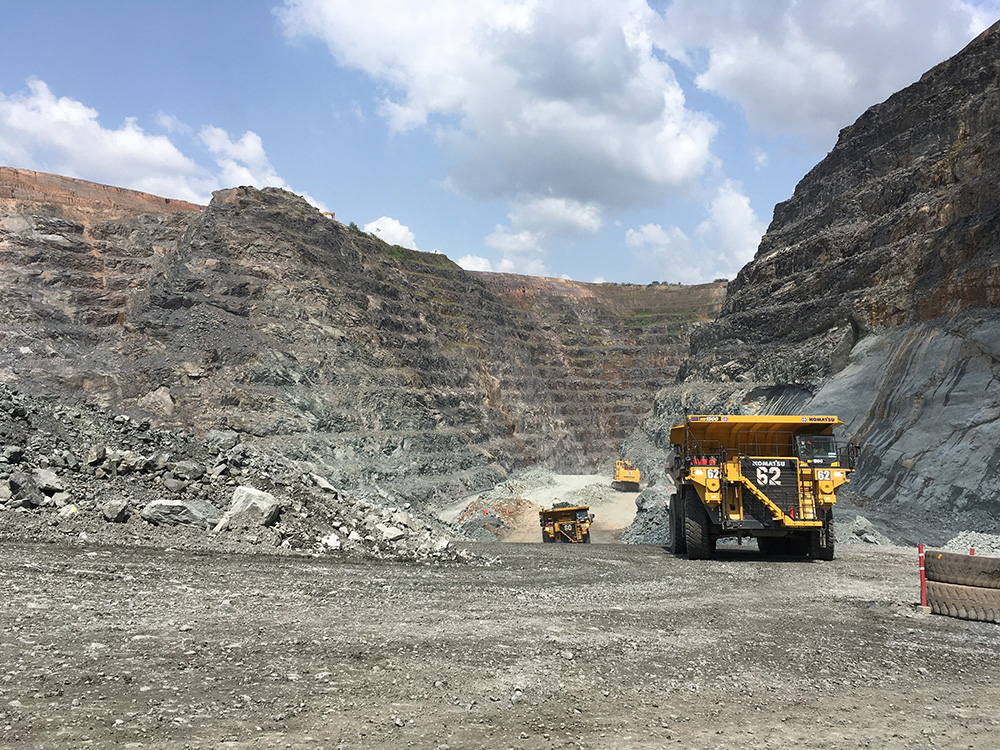
Perben’s 12,000-product-sales-a-year African market was one he knew very well, having spent eight years until joining Komatsu selling the manufacturer’s machines as general manager of BIA Africa, a highly successful off-highway machine distributor. Before joining BIA Africa, Perben spent 17 years at Volvo Group, working in varied managerial roles in Belgium, France, and Singapore.
“Over all my years in this industry, I’ve learned that the higher up you go, the more important it is to be in the field listening to customers and having a sense of what they need. You also need an enthusiastic and passionate team working with you and a workplace full of energy and fun,” he explains, adding, “In my eight years as general manager of BIA Africa, I developed an entrepreneurial spirit and learned how to manage risk. We grew the business substantially after significantly restructuring the company into different trading divisions. The company traded for Komatsu in five or six countries when I arrived and in another six by the time I left.”
Since establishing Komastu Africa, Perben has overseen an intense recruitment drive leading to employee numbers rising from three to 25. “We have two central offices, in Dakar, Senegal, and Nairobi, Kenya. They contain technical and marketing people who travel and support our distributors. To speak the same language as the customer, you need to have credibility. Credibility comes from spending a lot of time in the field – so I like to surround our team with experts.
“There are simple things you can do to generate big gains. In mining, quarrying and construction, an operator with bad habits means you lose 30% in fuel consumption. So, we have several Komatsu schools where our distributors can give technical training to our customers’ machine operators while offering customers expert business-operation advice.
“Additionally, Komatsu purchased two big machine-training simulator companies, Immersive Technologies and Oryx Simulations. Our new mining trucks have KomVision [Human Detection & Collision Mitigation System], so you can film truck operators at work and automatically detect and upload to the simulator footage of their faults over a 12-hour shift. The simulator will generate a training guide telling the operator what to do differently to improve their safety and fuel consumption.”
Perben stresses the quality of Komatsu Africa’s customer machine-servicing capabilities and distributor network, both strengthened under his leadership and reinforced by strong support from the company’s Japan-based CEO and executive management team. “Massive investment has gone into Komatsu’s global market warehousing site in Belgium, which was recently extended by 20,000m². The warehouse now has €500 million worth of parts and components, with €200 million of the inventory dedicated to mining customers. There is 95%-96% parts and components availability. Since last year, we have also been able to keep machine stock at a port in the Netherlands to shorten lead times. That and the warehouse extension were key parts of a growth plan I submitted to Komatsu Japanese senior management in 2021.
“These improvements have played a massive part in significantly increasing our African sales. We have also created a financing arm to help finance machine purchases by our African customers. It started three to four years ago, but we started actively marketing it in 2021. It’s 100% Komatsu financing. It makes a difference; we have real skin in the game!”
Perben says mining is the core business in Africa, with many countries developing their industry, keen to get to vast untapped minerals. He continues: “You have three types of customers: owner miners, contractor miners, and Chinese-run mines. The owner miners will take the biggest and most adaptive machinery. Contractor miners have to have a versatile fleet. They don’t have long-term-enough contracts and can’t commit to electric-powered machines. The Chinese miners tend to use a lot of smaller machines, which can create greater supply chain and human resources issues than in big mining nations like Australia and the United States.
“Surface and underground mining machines in our African market generally work with hard rock, whereas mines in southern African countries process a lot of softer rock. We are currently more involved with surface mining in Africa, but increasingly, surface mines are depleted, and underground mining is becoming more popular. We have varied customers – from those involved in small-scale gold mining to those running large-scale copper operations. These customers need dump trucks, for example, ranging from a 40-ton machine to a 400-ton electric model.

“Some mining markets that are supposed to be quite big have been depressed for quite a long time. Algeria, for example, should be a very big market. Its [off-highway machine] importers’ market has reopened after three years, creating new business opportunities. Elsewhere, we trade in three countries without elected governments: Mali, Guinea, and Burkina Faso. Mining is a large part of African countries’ GDP (Gross Domestic Product), and governments are getting royalties, so mines are largely unaffected.
“Other markets are more active and buoyant, like the DRC and Guinea, the latter where the largest iron ore mine in the world will open in Simandou. Guinea is also one of the largest bauxite producers globally. China wants to diversify its supply from Australia and the Americas, so it is diversifying and investing massively in Guinea’s bauxite mines. The same thing is happening in the DR with cobalt and copper.”
Perben says there is also a lot of mining industry development in Africa linked to the energy transition, with new metals mined, including lithium, graphite, and cobalt.
Although Komastu is in the African quarrying business, with quarries providing materials for road construction and other infrastructure works, Perben emphasises that it’s unlike Europe, where, he says, there is a very well-developed sector and some “massive” quarries.
So, where does Perben think the biggest growth for Komatsu Africa will come from in the next few years? “If you are talking about construction, the Ivory Coast and Kenya are undertaking big infrastructure development. To an extent, Ghana offers good sales opportunities, especially if it gets its affairs together with support from the IMF (International Monetary Fund). We are very focused on our African construction customer business and are making some very good inroads, with excellent support from Japan and our distributors.
“The DRC, Guinea and the Ivory Coast will be the biggest mining growth markets. Tanzania is coming back with a more stable government. Ethiopia, Eritrea and Mauritania are other countries looking to develop their mining business, presenting interesting commercial possibilities. Angola is also a good market for diamonds.”
Asked which Komatsu machines are proving most popular with African mining customers, Perben responds: “We have the reference machine in the 100-ton rigid dump truck class, the HD785. It is unmatched in terms of performance. The customers look at that as it has a massive presence in the market. We have HD785 customers whose truck has done more than 80,000 hours! That’s a lot when you consider it is working on your site for 5,000-7,000 hours a year when you are working 24/7. Those machines still have a mechanical availability above 85%.
“We also have one of the best 200-ton class excavators [PC2000] to load the HD785. They are an extremely good combination due to their lower lifecycle cost. For bigger mines, we have the highly productive HD1500 truck working, for example, in manganese mines. We don’t have much competition, other than Caterpillar, in that sized market. We also have autonomous mining trucks and have had them for more than 20 years, working for millions of hours. We also have 200 to 400-ton electric-drive trucks. The high power consumption is when the truck comes out of the pit, so we have several sites with a ‘trolley assist’ that reduces fuel consumption and carbon emissions.
“We have shovels starting from 120 tons to an 800-ton hydraulic shovel. We also have an electric rope shovel – a small 10.7m³, 18 metric tonnes per bucket one, all the way to a 70m³, 122 metric tonnes per bucket. We have the WE2350, the largest wheeled loader in the world, which gives you up to 72 tonnes per bucket. It can load up to 360-ton trucks. Nobody in the African mining machine market can match this range.”
Giving examples of how Komatsu’s machines have helped African mining customers, Perben says that there are customers in Senegal and Mali whose 100-ton trucks were involved in a site study by a Komatsu application engineer, which showed that with a side extension, the trucks could achieve a 15% additional payload while also dramatically reducing their cost per ton and total lifecycle cost.
He adds: “These productivity gains and cost savings are important as mining operations are judged on two things: one is output and meeting their promise to the market, and the second is their cost sustainability. Of course, fleet machinery is a big part of the latter, with processing plants another.
“We work hard to support our distributor to deliver continuous improvement for customers’ operations. For example, we do drone surveying and reprofiling of construction sites to ensure they are more efficient in their excavation and do things right the first time; that lowers customers’ cost per ton and operating costs. You get the deal [machine order] if you can prove that you can reduce a customer’s cost per ton.”

Perben says Komatsu plans to make available for African customers the same machine and fatigue-control-inclusive intelligent machines already offered in other international markets. “These machines position themselves with GPS and allow customers 3D joystick control. They can also talk to each other to align their work to improve production efficiencies through, for example, better bucket positioning. Just because we are working in Africa doesn’t mean that the machines and technology offered to customers should be sub-standard. The only difference is that we have machines that are fit for purpose to work in Africa, so we don’t have Tier 4 or 5 emission machines, only Tier 2 or 3, depending on the fuel quality.”
ESG (Environmental, Social & Corporate Governance) and digitalisation are critical issues for African mining, quarrying and construction customers, stresses Perben. “Decarbonisation is a sub-set of ESG and a big challenge for customers. We are big on reducing their Scope 1 and 2 emissions and are very supportive of reducing customers’ Scope 3 emissions, which comprise around 90% of carbon emissions and are linked to machine use. ESG used to be a nice thing to have at the back of a report; now, you have to measure it and prove that you are making a difference to the environment and your local community to continue to get work. It is good for business and the planet.”
Perben notes how EARTHBRAIN, a company created from a joint venture involving Komatsu, Sony Semiconductor Solutions Corporation and Nomura Research Institute, supports digital transformation in the global construction industry for dramatically improved safety, productivity and environmental performance.
He also highlights how Komatsu is working with some mining customers to rapidly innovate to support carbon-reduction targets. Through the Komatsu Greenhouse Gas (GHG) Alliance, Rio Tinto, BHP, Codelco, and Boliden are working directly with Komatsu to actively collaborate on product planning, development, testing and deployment of the next generation of zero-emission mining equipment and infrastructure. The alliance’s initial target is advancing Komatsu’s power-agnostic truck concept for a haulage vehicle that can run on various power sources, including diesel-electric, electric, trolley (wired), battery power and even hydrogen fuel cells.
As a company, Komatsu is committed to minimising environmental impact through its business, targeting a 50% reduction in CO2 emissions from using its products and production of its equipment by 2030 (compared to 2010 levels) and a challenging target of achieving carbon neutrality by 2050.
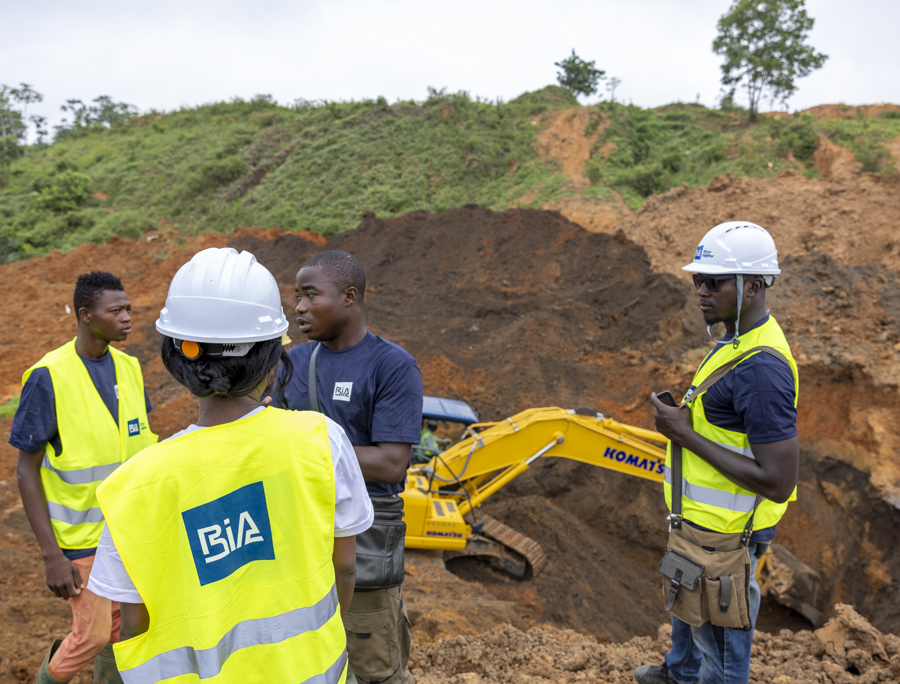
“We have a long history of doing good things for the environment,” continues Perben. “For example, we were the first manufacturer to offer widespread remanufacturing of factory components. When doing this, you are giving the core of the component back, meaning you have a component of the same level of quality as the original. We are so confident of this remanufactured quality that we offer a two-year warranty or 10,000 hours of service, whichever comes first. It shows the commitment of Komatsu to quality and the environment.”
While based at Komatsu Europe International’s headquarters in Vilvoorde, Belgium, Perben makes regular week-long trips to Africa, spending time in several countries on each visit. He also travels to Japan for face-to-face meetings with senior company management. “I’ve been to seven African countries in the past four months,” he says. “I’ve increased my time there, even though our staff numbers have grown. We have a huge diversity in the team, which I’m passionate about. They are doing great things. So great that I think we can reach our 2026 sales and income ambitions by the end of this year, so we are redefining our strategy to be even more ambitious.”
Asked whether Komatsu will look to establish manufacturing or parts warehouse facilities in Africa, Perben responds: “Until there is an economic zone like in the EU, it is very complicated to have parts warehousing in Africa. It is the same with manufacturing, as there is no critical mass, no single country in our African market that justifies a production facility. Also, if you want to transfer a machine between neighbouring African countries, it is sometimes quicker for the sending country to send it via a European port like Antwerp or Rotterdam. You can fit Russia between our two offices – Kenya in East Africa and Senegal in West Africa. That gives you an idea of the size and logistics of our market.”
Married for many years to a Dutch wife and the proud father of two daughters and a son, all in their 20s, Perben is a fully qualified sailing instructor, with a lifelong passion for the sport. He has many fond memories of outings with students on his boat, Optimist, off the Brittany coast in northern France.
Given his demanding Komatsu Africa leadership role, does he still get a chance to sail? “I keep two boats in the French Mountains near Gap [in the Provence-Alpes-Côte d’Azur region of Southeastern France], where there is a big artificial lake and a lot of wind, which is great for sailing. I used to do a regatta, but now I only tend to sail in the summer. My work with Komatsu does not leave much time for anything else.”

